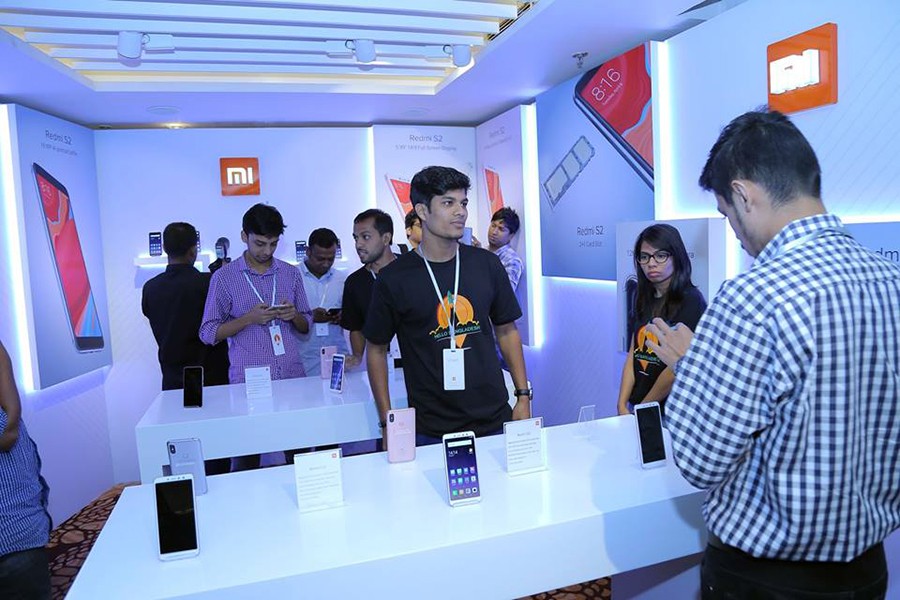The imports of mobile phones slumped by 17 per cent in last year, as increased duty on cellular handsets weighed on the purchase by price-sensitive customers.
Even the recent introduction of 4G services has failed to unleash expected boom in cellphone sales as the coverage of the 4G network remains limited and the price of 4G-enabled smartphones remains high.
The current situation of the local handset market has been portrayed in the latest report of the International Data Corporation (IDC), a global market intelligence firm.
Cellphone vendors in Bangladesh brought in a total of 28.5 million units in the year 2018, resulting in a year-over-year (YoY) decline of 17 per cent, according to IDC's latest mobile phone tracker for the Asia Pacific region.
Meanwhile, some 6.9 million units of smartphones were imported in 2018, down from 8.1 million units in 2017.
This was the first time when both smartphone and feature phone categories saw negative growth in the country- the IDC report noted.
Feature phone segment still remains the dominant category with 76 per cent share, but its imports slipped to 21.6 million units in 2018 compared to 26.1 million in 2017, it added.
4G services were launched by telcos in Bangladesh in Q1 2018.
"Due to the limited coverage of the 4G network and the higher price of 4G enabled smartphones, the uptake of 4G smartphones in the country has been slow," the IDC said in a statement published last week.
Telecom operators initiated a couple of partnerships with the device makers to sell affordable co-branded smartphones in the country, to upgrade the lower generation users to the 4G network.
However, this wasn't a strong catalyst for the smartphone category to maintain its ongoing growth from 2017 to this year, the global marketing intelligence firm said.
The IDC report noted mobile phones vendors in the country have struggled to manage their pricing against the increased duty structure.
The larger impact of such increased customs duty was seen in the feature phone category, where the small local vendors were unable to absorb the higher cost, and lost the share to Transsion and HMD (Nokia) in the lower tier cities, the IDC data found.
Meanwhile, import duty on mobile phones has indeed been on an upward curve in recent years.
In 2017, the government doubled the customs duty on imported mobile phones from 5.0 per cent to 10 per cent.
Even in the latest budget, the surcharge on the import of handsets doubled, increasing from 1.0 per cent to 2.0 per cent.
In total, mobile importers currently have to pay about 31 per cent import duty on the shipment of mobile phones.
Industry insiders have often complain about rising import duty, which is ultimately encouraging illegal mobile phone shipment in the country and depriving the government of revenue.
"While there has always been notable presence of illegally imported phones in the local market, the trend has picked up pace since 2016," president of the Bangladesh Mobile Phone Importers Association Ruhul Alam Al Mahbub told the FE.
While the share of illegally imported handsets stood at around 20 per cent just a year ago, it has increased to 30 per cent by the year 2018, according to the association's estimates.
The IDC market analysis identified a strong growth of 'Android Go' edition smartphones in the recent times.
The share of Android Go smartphones increased to 43 per cent from 29 per cent in Q3 2018, an impressive 51 per cent QoQ growth in Q4 2018, it noted.
In fact, HMD was the first player to launch the Go edition smartphone in the country.
However, Symphony, a local player, quickly identified the potential in the market and swiftly moved its portfolio to Go edition smartphones, thereby leading the category with a 39 per cent share in this segment in Q4 2018.
Analysing the reason for the growing popularity of this Android Go edition, the IDC experts explained this particular version of Android operating system allows the vendors "to keep hardware cost low without compromising much on the experience".
"As the market is very price sensitive, it is difficult for vendors to upgrade to higher specifications, which also command a higher price. However, Android Go is working here as a rescue catalyst," said Jaipal Singh, Associate Research Manager of IDC.
When it comes to brand wise market share, Symphony continued to hold the leadership position in the country with a 22 per cent market share in Q4 2018, the IDC analysis found.
However, its import purchase declined by 3.0 per cent from the previous quarter and 20 per cent from the same period last year.
Meanwhile, Transsion held the second position with a market share of 12 per cent although its shipments declined both sequentially and annually in Q4 2018.
Both Symphony and Transsion ventured into local assembling last year, a strategy which is likely to define their aggressive business plans in the coming years, according to the IDC report.
Chinese brand Xiaomi has displaced South Korean giant Samsung from the 3rd position in the local market as it doubled its shipments in Q4 2018 when compared to the same time a year ago.
Redmi 6A and Redmi 6 were the new top-selling models of the vendor contributing 56 per cent to its overall shipments.
Samsung ended at the fourth position in Q4 2018 as its shipments witnessed a YoY decline of 31 per cent from Q4 2017.
Its Galaxy J2 4G variant continued to be the top-selling model owing to its lower price as compared to the other Samsung models.
The brand is likely to bounce back with the launch of its upcoming "M-series" in Q1 2019, the IDC analysis suggests
Meanwhile, Huawei captured the fifth position as its shipments increased by 4.0 per cent YoY in Q4 2018.
Its 3G model Y3 (2017) continued to be the most popular device contributing to one-third of the brand's shipments.


